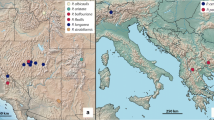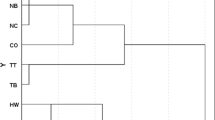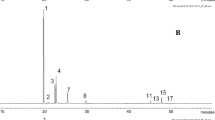Abstract
The proportion of monoterpenes and enantiomeric ratios of chiral monoterpenes were determined in two susceptible and two resistant varieties of Scotch pine, Pinus sylvestris, by capillary GC analysis of headspace volatiles emitted by 9-year-old trees. Half the trees sampled in each variety had been wounded by Dioryctria zimmermani, while the other half were unwounded. The presence of wounds had no significant (P < 0.05) effect on the proportion of monoterpenes or the ratio of enantiomers of each of the optically resolved monoterpenes in the four varieties. In contrast, monoterpene composition varied significantly (P < 0.05) among varieties. However, the results do not entirely support the putative role of car-3-ene and terpinolene as an oviposition stimulant for D. zimmermani in resistant varieties of Scotch pine. Although the resistant Lake Superior Blue virtually lacked these two monoterpenes, the resistant Belgian had a relatively high concentration of car-3-ene and terpinolene. Both resistant varieties, however, emitted relatively high levels of limonene, a monoterpene associated with increased oviposition in three other Dioryctria species. There was no evidence linking enantiomeric composition of chirally resolved monoterpenes with varietal resistance. The relative importance of monoterpenes as resistance factors and oviposition stimulants is discussed.
Similar content being viewed by others
REFERENCES
Alfaro, R. I., Pierce, H. D., Jr., Borden, J. H., and Oehlschlager, A. C. 1980. Role of volatile and nonvolatile components of Sitka spruce bark as feeding stimulants for Pissodes strobi Peck (Coleoptera: Curculionidae). Can. J. Zool. 58:626-632.
Carlson, R. B., and Butcher, J. W. 1967. Biology and behavior of Zimmerman pine moth, Dioryctria zimmermani, in Michigan. Can. Entomol. 99:529-436.
Coyne, K. F., and Lott, L. H. 1976. Toxicity of substances in pine oleoresin to southern pine beetles. J. Ga. Entomol. Soc. 11:301-305.
Fatzinger, C. W., and Merkel, E. P. 1985. Oviposition and feeding preferences of the southern pine coneworm (Lepidoptera: Pyralidae) for different host-plant materials and observations on monoterpenes as an oviposition stimulant. J. Chem. Ecol. 11:689-699.
Hanula, J. L., Berisford, C. W., and Debarr, G. L. 1985. Monoterpene oviposition stimulants of Dioryctria amatella in volatiles from fusiform rust galls and second year loblolly pine cones. J. Chem. Ecol. 11:943-952.
Heinrich, C. 1956. American moths of the subfamily Phycitinae. USNM Bul. 207, Smithsonian Institution, Washington, D.C.
Jactel, H., Menassieu, P., and Raise, G. 1994. Infestation dynamics of Dioryctria sylvestrella (Ratz.) (Lepidoptera: Pyralidae) in pruned maritime pine (Pinus pinaster Ait.). For. Ecol. Manage. 67:11-22.
Jactel, H., Menassieu, P., Raise, G., and Burban, C. 1996a. Sensitivity of pruned maritime pine (Pinus pinaster Ait) to Dioryctria sylvestrella Ratz. (Lep., Pyralidae) in relation to tree vigour and date of pruning. J. Appl. Entomol. 120:147-153.
Jactel, H., Kleinhentz, M., Marpeau-Bezard, A., Marion-Poll, F., Menassieu, P., and Burban, C. 1996b. Terpene variations in maritime pine constitutive oleoresin related to host tree selection by Dioryctria sylvestrella Ratz. (Lepidoptera: Pyralidae). J. Chem. Ecol. 22:1037-1050.
Klepzig, K. D., Kruger, E. L., Smalley, E. B., and Raffa, K. F. 1995. Effects of biotic and abiotic stress on induced accumulation of terpenes and phenolics in red pines inoculated with bark beetle-vectored fungus. J. Chem. Ecol. 21:601-626
Nordlander, G. 1990. Limonene inhibits attraction to α-pinene in the pine weevils Hylobies abietis and H. pinastri. J. Chem. Ecol. 16:1307-1320.
Popp, M. P., Johnson, J. D., and Lesney, M. S. 1995. Characterization of the induced response of slash pine to inoculation with bark beetle vectored fungi. Tree Physiol. 15:619-623.
Raffa, K. F. 1991. Induced defensive reactions in conifer-bark beetle systems, pp. 245-276, in D. W. Tallamy and M. J. Raupp (eds.). Phytochemical Induction by Herbivores. John Wiley & Sons, New York.
Raffa, K. F., and Smalley, E. B. 1995. Interaction of pre-attack and induced monoterpene concentrations in host conifer defense against bark beetle-fungal complexes. Oecologia 102:285-295.
Raffa, K. F., Berryman, A. A., Simasko, J., Teal, W., and Wong, B. L. 1985. Effects of grand fir monoterpenes on the fir engraver, Scolytus ventralis (Coleoptera: Scolytidae), and its symbiotic fungus. Environ. Entomol. 14:552-556
Ruby, J. L., and Wright, J. W. 1976. A revised classification of geographic varieties in Scots pine. Silvae Genet. 25:169-175.
Sadof, C. S. 1996. Resistance of Scotch pine varieties to Zimmerman pine moth (Lepidoptera: Pyralidae) and its impact on sales in a choose and cut Christmas tree plantation. Great Lakes Entomol. 29:183-190.
Sas Institute. 1985. SAS User's Guide: Statistics, Version 5 Edition. SAS Institute Inc., Cary, North Carolina, 956 pp.
Shu, S., Grant, G. G., Langevin, D., Lombardo, D., and Macdonald, L. 1997. Oviposition and electroantennogram responses of Dioryctria abietivorella (Lepidoptera: Pyralidae) elicited by host monoterpenes and their enantiomers. J. Chem. Ecol. 23:35-50.
Sturgeon, K. B. 1979. Monoterpene variation in ponderosa pine xylem resin related to western pine beetle predation. Evolution 33:803-814.
Tobolski, J. J., and Hanover, J. W. 1971. Genetic variation of the monoterpenes of Scotch pine. For. Sci. 17:293-299.
ValterovÁ, I., SjÖdin, K., Vroc, J., and Norin, T. 1995. Contents and enantiomeric composition of monoterpene hydrocarbons in xylem oleoresins from four Pinus species growing in Cuba. Comparison of trees unattacked and attacked by Dioryctria horneana. Biochem. Syst. Ecol. 23:1-15.
Wright, J. W., Wilson, L. F., and Bright, J. N. 1975. Genetic variation in resistance of Scotch pine to Zimmerman pine moth. Great Lakes Entomol. 8:231-236.
Yonker, J. W., and Schuder, D. L. 1987. Appearance of damage symptoms and reinfestation rates for Christmas trees attacked by the Zimmerman pine moth, Dioryctria zimmermani (Lepidoptera: Pyralidae). Great Lakes Entomol. 20:25-29.
Author information
Authors and Affiliations
Rights and permissions
About this article
Cite this article
Sadof, C.S., Grant, G.G. Monoterpene Composition of Pinus sylvestris Varieties Resistant and Susceptible to Dioryctria zimmermani . J Chem Ecol 23, 1917–1927 (1997). https://doi.org/10.1023/B:JOEC.0000006479.39087.60
Issue Date:
DOI: https://doi.org/10.1023/B:JOEC.0000006479.39087.60




